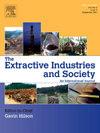Prakuam: Local knowledge commodification and preservation of Khmer silverware techniques and objects in Surin Province of Thailand
IF 3.6
2区 社会学
Q2 ENVIRONMENTAL STUDIES
Extractive Industries and Society-An International Journal
Pub Date : 2025-01-09
DOI:10.1016/j.exis.2024.101607
引用次数: 0
Abstract
Drawing on ethnographic research, this paper examines the background and commodification of Prakuam as a cultural heritage among Khmer ethnic communities in Surin Province, Thailand. The study was guided by a key informant, Lung Puan Jiewthong, a master silversmith selected from Chok Village in Khawao-Sinarin District, Surin Province, along with secondary data. The findings provide detailed insights into the backgrounds and cultural identities of the inhabitants of these ethnic communities. Prakuam refers to methods and styles of silverware-making that have been practiced over hundreds of years. Some silversmiths can trace their lineages to artist communities that existed during the Khmer Empire; local knowledge and techniques have been, and continue to be, transmitted from generation to generation. Prakuam objects and patterns manifest local identities and beliefs, with silver holding essential meanings and functions in Surin Province, particularly in the silverware-making village of Khwao Sinarin. Present-day silver products from Khwao Sinarin are consumed both locally and nationally. The popularity of Prakuam has spread, in part, due to craft promotion programs like One Tambon One Product (OTOP), which have significantly impacted community life in Surin Province. However, the emphasis on economic survival in a globalized world has diluted the significance of local cultural practices and meanings associated with Prakuam. A sizable portion of the belief system is lost when Prakuam is viewed solely as a market commodity, and OTOP programs fail to actively foster sustainable cultural preservation. The findings emerging from this research can be used to craft holistic, contextually-appropriate cultural preservation policies that are responsive to the dynamics of today's society.
Prakuam:泰国素林省高棉银器技术和器物的本地知识商品化和保存
本文以民族志研究为基础,探讨泰国素林省高棉族群文化遗产Prakuam的背景与商品化。这项研究的指导是由一个关键的信息提供者,从苏林省Khawao-Sinarin区Chok村选出的银匠大师Lung Puan Jiewthong,以及二手数据。这些发现为了解这些民族社区居民的背景和文化身份提供了详细的见解。Prakuam指的是数百年来一直在实践的银器制作方法和风格。一些银匠的血统可以追溯到高棉帝国时期的艺术家社区;当地的知识和技术已经并将继续代代相传。Prakuam的物品和图案体现了当地的身份和信仰,白银在素林省具有重要的意义和功能,特别是在银器制造村Khwao Sinarin。如今,华沃西林的银制品在当地和全国都被消费。Prakuam广受欢迎,部分原因是像One Tambon One Product (OTOP)这样的工艺推广项目,这些项目对素林省的社区生活产生了重大影响。然而,在全球化的世界中,对经济生存的强调削弱了与Prakuam相关的当地文化习俗和意义的重要性。当Prakuam仅仅被视为一种市场商品时,相当一部分信仰体系就会丢失,而OTOP项目也未能积极促进可持续的文化保护。这项研究的结果可以用来制定整体的、与环境相适应的文化保护政策,以响应当今社会的动态。
本文章由计算机程序翻译,如有差异,请以英文原文为准。
求助全文
约1分钟内获得全文
求助全文
来源期刊

Extractive Industries and Society-An International Journal
ENVIRONMENTAL STUDIES-
CiteScore
6.60
自引率
19.40%
发文量
135
 求助内容:
求助内容: 应助结果提醒方式:
应助结果提醒方式:


